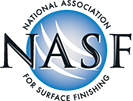| Presented in Partnership with: | |||
 |
 |
 |
 |
1/10/96
Richard Klitchman
Senior Environmental Engineer
Whirlpool Corporation
151 North Riverview Drive
Benton Harbor, Michigan 49022-3619
Dear Mr. Klitchman:
This is in response to your November 22, 1995, request for a letter documenting an exemption from Title V permitting requirements of the Clean Air Act for your chrome plating process.
Your letter stated that you discussed your process with the Michigan Department of Environmental Quality (MDEQ) regarding the differences in your process from the chromium electroplating process which would be subject to the National Emission Standards for Chromium Emissions from Hard and Decorative Electroplating and Chromium Anodizing Tanks (Chrome Plating NESHAP). Subsequently, the United States Environmental Protection Agency (U.S. EPA) was also contacted regarding the differences in your process and the applicability of the chrome standard.
Your letter states that your process uses hexavalent chrome in an electrolytic passivation process and is different from either the hard or decorative chrome plating process. Functionally, the purpose of the passivation process is to provide additional corrosion protection to nickel plated parts. The chrome layer also acts as filler. The concentration of the plating solution is three ounces per gallon and the current density is ten to twelve amps per square foot.
Based on the information provided by Whirlpool Corporation to the U.S. EPA, the chromic acid concentration and the current density are far below typical hard and decorative electroplating parameters. Given the process parameters, chromium emissions from this operation are expected to be quite low. Also, the properties expected from the coating are not typical of either hard or decorative electroplating. Thus, the passivating tank is not subject to the Chrome Plating NESHAP.
There are several applicability requirements for the Michigan Title V Permitting Program. These minimum Federal requirements for the States program can be found at 40 C.F.R. Section 70.3 for several types of sources. Under 40 C.F.R. Section 70.3(a), the passivating tank alone would not trigger Title V applicability since it is not subject to the Chrome Plating NESHAP.
U.S. EPA is currently considering Michigans Title V Permit Program. If U.S. EPA approves this program, the MDEQ will be the Agency which determines if your facility is subject to Title V requirements. For this reason, we would like to suggest that Whirlpool contact the MDEQ for assistance in determining whether the facility is subject to the Title V Operating Permit Program.
If you have questions or need additional assistance regarding the applicability determination, please contact Karen Bell, of my staff, at
(312) 353-8640.
Sincerely yours,
George T. Czerniak, Chief
Air Enforcement and Compliance Assurance Branch
cc: Greg Waldrip, OECA
Diane Kavanaugh, MEDQ
 |
 |
 |
 |
 |
| Home | Subscribe | Regulations | Compliance Assistance | News | Resources | Resource Locators | Directories | Online Training | About | Search | NASF.org |
The information contained in this site is provided for your review and convenience. It is not intended to provide legal advice with respect to any federal, state, or local regulation.
You should consult with legal counsel and appropriate authorities before interpreting any regulations or undertaking any specific course of action.
Please note that many of the regulatory discussions on STERC refer to federal regulations. In many cases, states or local governments have promulgated relevant rules and standards
that are different and/or more stringent than the federal regulations. Therefore, to assure full compliance, you should investigate and comply with all applicable federal, state and local regulations.